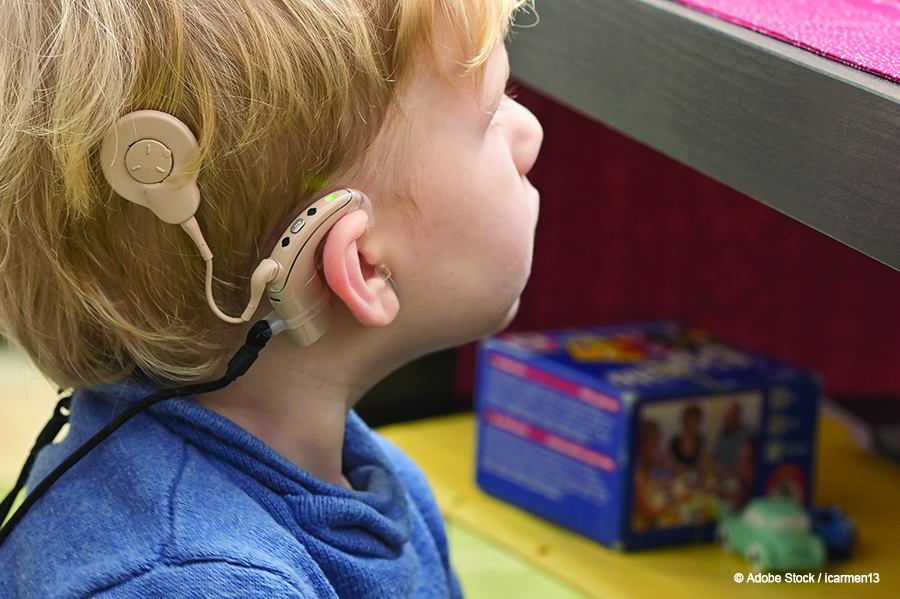 Unilateral hearing loss (UHL) is a condition that can have serious repercussions for development and a major quality-of-life impact on children, but deciding whether cochlear implantation is the answer can be a challenge, said experts here at the Combined Otolaryngology Spring Meetings while offering factors to consider.
Unilateral hearing loss (UHL) is a condition that can have serious repercussions for development and a major quality-of-life impact on children, but deciding whether cochlear implantation is the answer can be a challenge, said experts here at the Combined Otolaryngology Spring Meetings while offering factors to consider.
Explore This Issue
July 2024Kevin Brown, MD, PhD, executive director of the Children’s Cochlear Implant Center at the University of North Carolina in Chapel Hill, N.C., emphasized the importance of place–pitch match when determining which cochlear implant device to use in patients with single-sided deafness.
An individual’s cochlea expects to receive a certain frequency at a certain location—a phenomenon known as tonotopy.
“If you have a situation in which the implant perfectly aligns with what the cochlea is expecting to hear, then that is a place–pitch match,” he said. “By degree, if improperly aligned, you have a mismatch of cochlear place and the frequency the implant is presenting.” This mismatch is why some patients might report that “everything sounds sort of like Mickey Mouse”—everything is upshifted in place frequency, he said.
A study his group performed found that while mismatch did not have a substantial effect on speech perception in quiet, it did have an impact on speech perception in noise, which requires the integration of signals from both the normal hearing ear and the cochlear implant ear (Otol Neurotol. 2024;45:513-520).
The best option, these findings suggest, is that the longest or deepest electrode in a given company’s product line is what should be used, he said.
“We should be choosing these pre-operatively to try and minimize the impact of mismatch on speech perception in noise,” Dr. Brown said. “If not, this mismatch can lead to corruption of binaural cues to the detriment of speech perception in noisy environments.”
Samantha Anne, MD, MS, medical director of pediatric ear and hearing disorders at Cleveland Clinic’s Head and Neck Institute in Ohio, pointed to research that suggests there is an array of factors to consider when deciding which children with UHL are implant candidates.
Studies recently published by her group found that implant recipients can achieve satisfactory speech perception scores (Otolaryngol Head Neck Surg. 2024;170:1449-1455). In addition, the team’s research has shown that, even more than device usage itself, direct audio input—in which sound is fed directly to the device—during post-op rehabilitation was associated with higher scores, suggesting that isolated listening with the implanted ear could be important.
“I would argue that there are a lot of things that we need to think about (keeping in mind that there are emerging reports of some instances of non-use in these patients),” she said. These include motivation to use the implants, psychosocial support, quality-of-life considerations, duration of deafness, age at implantation, and the cause of the hearing loss, among others.
Sharon Cushing, MD, MSc, a professor in the department of otolaryngology–head and neck surgery at the University of Toronto in Canada, said that because children who are cytomegalovirus-positive and have single-sided hearing loss are at such a high risk of bilateral hearing loss, implantation is especially urgent in these children (Laryngoscope. 2022:132 Suppl 11:S1-S24).
“We look at implantation for single-sided deafness in these children as the first stage of maintaining bilateral hearing,” she said.
Studies have shown that cochlear implants can, in early-onset single-sided deafness, lead to the development of normal aural preference, in which the right brain attends to the left ear and vice versa, and which Dr. Cushing said is “the foundation of bilateral hearing.”
Users are also able to determine which side sound is coming from, she said, but aren’t able to really localize sounds.
She pointed to the lack of implant use in 11% of users in one study as a problem — not so much among prelingual patients, for whom parents are making sure to place the implants, but more so among late-onset users (Otol Neurotol. 2023;44:233-240).
“Some of these families tried it for 100 months and ended up in non-use,” she said. “So it is interesting to look at these characteristics to really try and figure out who we can help with this.”
Thomas R. Collins is a freelance medical writer based in Florida.